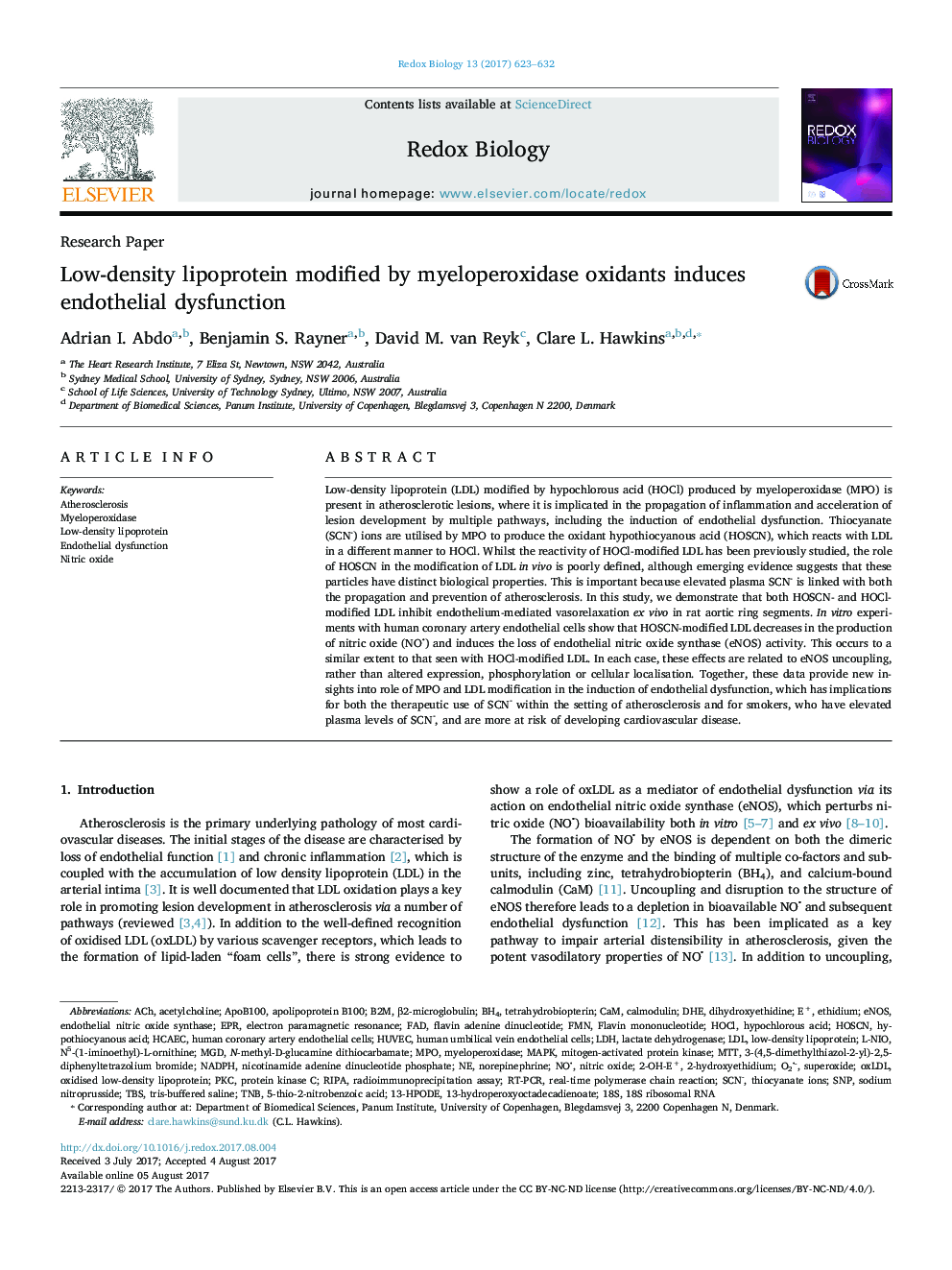| Article ID | Journal | Published Year | Pages | File Type |
|---|---|---|---|---|
| 8286930 | Redox Biology | 2017 | 10 Pages |
Abstract
Low-density lipoprotein (LDL) modified by hypochlorous acid (HOCl) produced by myeloperoxidase (MPO) is present in atherosclerotic lesions, where it is implicated in the propagation of inflammation and acceleration of lesion development by multiple pathways, including the induction of endothelial dysfunction. Thiocyanate (SCN-) ions are utilised by MPO to produce the oxidant hypothiocyanous acid (HOSCN), which reacts with LDL in a different manner to HOCl. Whilst the reactivity of HOCl-modified LDL has been previously studied, the role of HOSCN in the modification of LDL in vivo is poorly defined, although emerging evidence suggests that these particles have distinct biological properties. This is important because elevated plasma SCN- is linked with both the propagation and prevention of atherosclerosis. In this study, we demonstrate that both HOSCN- and HOCl-modified LDL inhibit endothelium-mediated vasorelaxation ex vivo in rat aortic ring segments. In vitro experiments with human coronary artery endothelial cells show that HOSCN-modified LDL decreases in the production of nitric oxide (NO
- ) and induces the loss of endothelial nitric oxide synthase (eNOS) activity. This occurs to a similar extent to that seen with HOCl-modified LDL. In each case, these effects are related to eNOS uncoupling, rather than altered expression, phosphorylation or cellular localisation. Together, these data provide new insights into role of MPO and LDL modification in the induction of endothelial dysfunction, which has implications for both the therapeutic use of SCN- within the setting of atherosclerosis and for smokers, who have elevated plasma levels of SCN-, and are more at risk of developing cardiovascular disease.
- ) and induces the loss of endothelial nitric oxide synthase (eNOS) activity. This occurs to a similar extent to that seen with HOCl-modified LDL. In each case, these effects are related to eNOS uncoupling, rather than altered expression, phosphorylation or cellular localisation. Together, these data provide new insights into role of MPO and LDL modification in the induction of endothelial dysfunction, which has implications for both the therapeutic use of SCN- within the setting of atherosclerosis and for smokers, who have elevated plasma levels of SCN-, and are more at risk of developing cardiovascular disease.
Keywords
NADPHRIPAeNOSPKCHOClHUVEC18SHCAECRT-PCRBH4TBStetrahydrobiopterinMGDApoB100FMNflavin adenine dinucleotideN-methyl-d-glucamine dithiocarbamate13-HPODEoxLDLTNBHOSCNO2•-b2m2-OH-E+2-hydroxyethidium3-(4,5-dimethylthiazol-2-yl)-2,5-diphenyltetrazolium bromideL-NIOMPOMAPKMTTNO•18S ribosomal RNAβ2-microglobulinAtherosclerosisAChapolipoprotein B100EthidiumEndothelial dysfunctionAcetylcholine5-thio-2-nitrobenzoic acidhypothiocyanous acidhypochlorous acidFADTris-buffered salineEPRElectron paramagnetic resonanceCAMhuman coronary artery endothelial cellsHuman umbilical vein endothelial cellsendothelial nitric oxide synthaseradioimmunoprecipitation assaySuperoxideflavin mononucleotidelactate dehydrogenaseLDHOxidised low-density lipoproteinLow-density lipoproteinLDLmyeloperoxidasenorepinephrinesodium nitroprussideNitric oxidenicotinamide adenine dinucleotide phosphateDHEreal-time polymerase chain reactionProtein kinase Cmitogen-activated protein kinaseSNPCalmodulinthiocyanate ions
Related Topics
Life Sciences
Biochemistry, Genetics and Molecular Biology
Ageing
Authors
Adrian I. Abdo, Benjamin S. Rayner, David M. van Reyk, Clare L. Hawkins,
